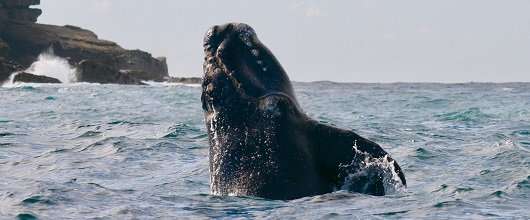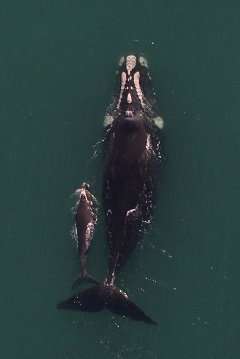Migration patterns changed among threatened whale population

Climate change has potentially had a major effect on the migration of southern right whale populations, research led by the University of St Andrews has found.
The species has long been the target of hunters, being large, slow-swimming and yielding large quantities of oil. Globally, the species declined from as many as 150,000 before whaling to around 400 whales in 1920. Today, southern right whales are recovering in some areas, with a potential world population of 15,000 whales.
However, the new research, published in the journal Heredity today (Thursday 3 May) suggests that there is evidence of an increased connectivity among populations of southern right whales that has been shaped by both behavioural mechanisms and climate change affecting sea levels over time.
Dr. Emma Carroll of the University of St Andrews said: "As right whales can easily swim thousands of kilometres, we think it likely that behaviour was driving the historical isolation and its subsequent breakdown. Such behaviours, like migratory fidelity, probably continue to shape population structure today."
A global collaboration of scientists from 15 institutes in eight countries, led by Dr. Carroll of the Scottish Oceans Institute (SOI) and the Sea Mammal Research Unit (SMRU) at the University, used a large dataset of genetic markers from more than 1300 individual whales, which enabled levels of genetic diversity and population structure to be characterised with both maternally and bi-parentally inherited DNA markers for the first time.

The analysis suggests that southern right whales in the South Atlantic (Argentina and South Africa) and Indo-Pacific (Australia and New Zealand) were largely isolated until around 25,000 years ago – the beginning of a warm interglacial period when a dramatic rise in sea level changed the shallow seas around the Southern Hemisphere.
Significant differences in both maternally-inherited and bi-parentally inherited DNA markers among the whale wintering grounds today, discovered by the research team, are consistent with long-term photo-ID and genetic monitoring work demonstrating that females, and sometimes males, regularly return to the same wintering ground for decades.
Both findings will help to manage the species as it recovers from whaling and Dr. Carroll will present the findings to the Scientific Committee of the International Whaling Commission.
Fidelity to migratory destinations is known to shape population structure of many marine species, including turtles, sharks and other whales. However, the warm interglacial period probably disrupted the shallow, coastal areas that southern right whales use as winter calving and socialising areas. The researchers hypothesise that this could have prompted whales to disperse in search of new areas, meaning there was more connectivity between previously isolated areas.
More information: E. L. Carroll et al. Incorporating non-equilibrium dynamics into demographic history inferences of a migratory marine species, Heredity (2018). DOI: 10.1038/s41437-018-0077-y
Journal information: Heredity
Provided by University of St Andrews



















